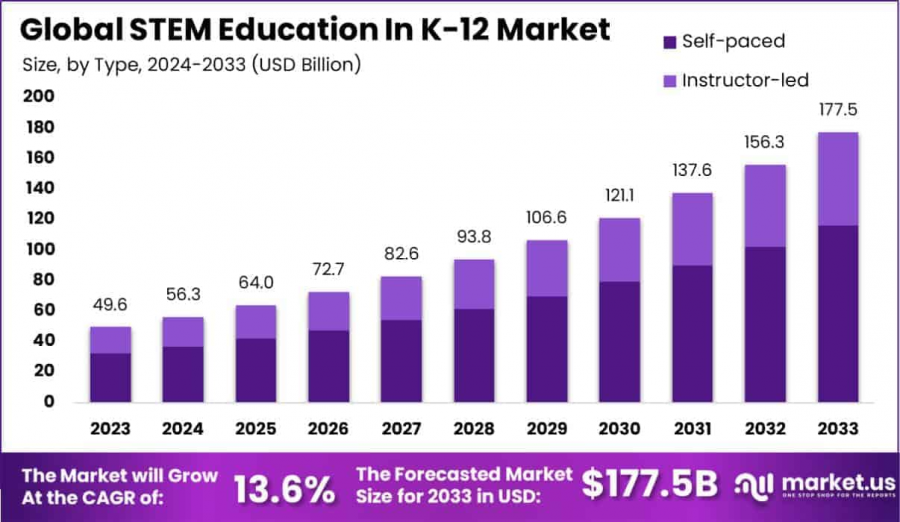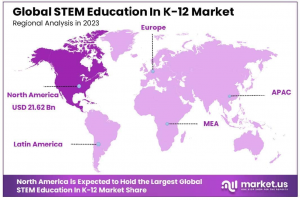
STEM Education In K-12 Market Boost Worth around USD 177.5 Billion By 2033, Region Growing at a CAGR of 13.6%
In North America, the market is particularly strong, holding a dominant share of 43.6% with a valuation of USD 21.62 billion...
NEW YORK, NY, UNITED STATES, January 24, 2025 /EINPresswire.com/ -- The Global STEM Education in K-12 Market is set for significant growth, with an expected market size of USD 177.5 billion by 2033, up from USD 49.6 billion in 2023, reflecting a robust CAGR of 13.6% during the forecast period from 2024 to 2033.
Several factors are driving this growth, including the increasing demand for a skilled workforce in science, technology, engineering, and mathematics fields. As industries across the globe face skill shortages, governments, and educational institutions are placing a stronger emphasis on integrating STEM education into K-12 curriculums to better prepare students for future careers.
The rising adoption of digital learning tools, such as online platforms, coding programs, and interactive STEM kits, is significantly transforming the learning experience. Technology is playing a critical role in enhancing engagement and accessibility to quality education. The rise of AI, virtual labs, and gamified learning platforms is making STEM subjects more interactive and practical, thereby attracting students and educators alike.
🔺 Click Here To Get a PDF Research Sample (no cost) @ https://market.us/report/stem-education-in-k-12-market/request-sample/
Market demand is also being fueled by various government initiatives and funding aimed at supporting STEM programs in schools. These efforts are driving the development of new, innovative teaching methods and resources to meet the growing need for advanced STEM skills. As technological advancements continue to evolve, the STEM education market is expected to flourish, shaping the future workforce and fostering innovation in industries worldwide.
Key Statistics
Government Investment: The Indian government has allocated ₹93,224 crore (approximately $12 billion) in 2022 to foster STEM education under the National Education Policy (NEP) 2020, signaling a strong commitment to enhancing scientific and technological competencies among students.
Student Enrollment: STEM course enrollment figures show consistent growth, from 1.5 million students in 2022 to an anticipated 1.8 million by 2024, reflecting a growing emphasis on STEM education as critical for national and individual development.
Digital Learning Tools: In 2022, 70% of K-12 schools had access to digital learning resources, a number projected to increase to 85% by 2024. This shift highlights the increasing role of digital tools in making STEM education more interactive and accessible.
Budget Allocations for STEM Infrastructure: The Indian government has allocated ₹1,500 crore for STEM education infrastructure in 2023, which is set to increase to ₹1,800 crore in 2024. This increase in budget reflects a forward-looking approach aimed at enhancing educational resources and supporting the development of a technologically skilled workforce.
🔺 Get the Full Report at Exclusive Discount (Limited Period Only) @ https://market.us/purchase-report/?report_id=127488
Key Takeaways:
The Global STEM Education in K-12 Market is projected to reach USD 177.5 billion by 2033, growing from USD 49.6 billion in 2023, with a CAGR of 13.6% from 2024 to 2033.
In 2023, the Self-paced learning segment dominated the market, capturing more than 65.4% of the share, reflecting the growing trend toward personalized and flexible learning in STEM education.
The High School (9-12) segment led the market in 2023, accounting for over 42.5% of the market share in the By Application category, driven by the increasing integration of STEM programs at the high school level.
North America held a dominant share of 43.6% of the STEM Education in the K-12 market in 2023, with a revenue of USD 21.62 billion, bolstered by significant investments and a strong educational infrastructure supporting STEM education initiatives.
Experts Review
The STEM Education in the K-12 market is experiencing robust growth, driven by strong government incentives and technological innovations. Governments worldwide, particularly in countries like India and the U.S., are heavily investing in STEM programs to develop future-ready workforces. The National Education Policy (NEP) 2020 in India and similar initiatives in other regions have led to significant budget allocations, such as India’s ₹93,224 crore (around $12 billion) funding in 2022. These investments focus on creating a foundation for advanced learning technologies and infrastructure.
Technological innovations, such as AI-driven personalized learning, virtual labs, and gamified STEM platforms, are transforming the educational experience. These innovations not only enhance engagement but also enable scalable and efficient learning models, making STEM education more accessible.
Investment opportunities abound, with educational technology startups attracting significant funding. However, risks related to data privacy, security, and the integration of digital tools into traditional educational systems remain.
Increasing consumer awareness about the importance of STEM education is pushing demand for more innovative, tech-driven solutions. The market’s impact is profound, as technology shapes educational methodologies, improving learning outcomes. However, the regulatory environment is evolving, and governments are working on frameworks that ensure data privacy, security, and ethical use of AI in education while fostering innovation. Balancing these factors will be crucial for the sustained growth of the market.
🔺 Get a PDF Research Sample (no cost) @ https://market.us/report/stem-education-in-k-12-market/request-sample/
Report Segmentation
Type: The market is primarily divided into Self-paced learning and Instructor-led learning. The Self-paced learning segment holds a dominant market share due to the growing adoption of online platforms and personalized learning tools, which allow students to learn at their own pace. These tools have become more popular as they offer flexibility and convenience, especially during the pandemic and beyond. Instructor-led learning continues to play a significant role, particularly in traditional classroom settings.
Application: The High School (9-12) segment leads the market in terms of STEM education implementation, capturing the largest share. This is largely driven by the integration of specialized STEM programs and resources at the high school level to prepare students for higher education and STEM-related careers. The Middle School (6-8) and Elementary (K-5) segments are also growing rapidly, as STEM concepts are being introduced earlier to establish a strong foundation.
Region: The market is geographically segmented into North America, Europe, Asia-Pacific, and the Rest of the World. North America holds the largest share, supported by significant investments in educational infrastructure and technology. Asia-Pacific is experiencing rapid growth due to increasing government initiatives and the rising demand for STEM skills in emerging economies.
Key Market Segments
By Type
-- Self-paced
-- Instructor-led
By Application
-- Elementary School (K-5)
-- Middle School (6-8)
-- High School (9-12)
Major Factors
Drivers: The STEM Education in the K-12 market is driven by several key factors. Growing demand for a skilled workforce in science, technology, engineering, and mathematics (STEM) fields is propelling the adoption of STEM education at the K-12 level. Government initiatives, such as the National Education Policy (NEP) in India and other similar policies globally, are increasing investments in STEM education. Technological advancements, including AI-powered learning tools, virtual labs, and gamified STEM programs, are enhancing learning experiences, and making STEM subjects more engaging and accessible.
Restraints: Despite growth, the market faces challenges such as high implementation costs for advanced educational technologies. The integration of digital tools into traditional educational settings can be resource-intensive, especially in underfunded schools. Additionally, data privacy concerns and the need for robust cybersecurity measures in digital learning platforms can limit adoption.
Challenges: A major challenge is the digital divide, where schools in rural or underserved areas may not have access to the same technological resources as their urban counterparts. Furthermore, teacher training is essential to ensure effective use of new STEM teaching tools, and the shortage of skilled instructors may hinder market progress.
Opportunities: The market presents ample opportunities for innovation, especially in digital learning platforms and AI-driven personalized education tools. The increasing emphasis on early STEM education and global collaboration in research and development opens doors for growth, with governments and institutions investing in infrastructure and resources to support the demand for STEM-skilled workers.
🔺 Hurry Exclusive Discount For Limited Period Only @ https://market.us/purchase-report/?report_id=127488
Key Player Analysis
Microsoft – A major player in the K-12 STEM education sector, Microsoft offers tools like Minecraft Education Edition and Azure for Education to engage students in STEM learning through gamification and cloud-based platforms. Its focus on cloud computing and AI in education has made it a key contributor to modernizing STEM education globally.
Google for Education – Google Classroom, Google Meet, and Google Earth tools are widely used in STEM classrooms, enabling interactive learning and collaboration. Google is expanding its AI and machine learning tools to help educators personalize learning, particularly in STEM subjects.
Apple – Apple offers a range of educational tools like Swift Playgrounds, which teach coding and app development to students. Apple’s emphasis on creative problem-solving and its ecosystem of devices makes it a strong player in K-12 STEM education.
IBM – IBM’s STEM Education Programs focus on using AI, data science, and coding to prepare students for the future workforce. Its initiatives support schools and students in learning through real-world applications of STEM concepts.
Top Key Players in the Market
Amplify Education, Inc.
Bedford School
Carolina Biological Supply Company
Cengage Group
Discovery Education
EduCo International
Houghton Mifflin Harcourt
Kendall Hunt Publishing Company
Lab-Aids
McGraw Hill
OpenSciEd
PASCO Scientific
School Specialty, LLC
Recent Developments
Government Initiatives: Many countries, including India with its National Education Policy (NEP) 2020, have allocated significant budgets to strengthen STEM education. India earmarked ₹93,224 crore (approx. $12 billion) in 2022 to promote STEM fields, with increased focus on early-stage education.
EdTech Innovations: Companies like Microsoft and Google for Education have introduced new tools such as Minecraft Education Edition and Google Classroom to engage students through interactive learning experiences. These tools allow students to learn coding, robotics, and other STEM subjects in a gamified, hands-on way.
AI Integration: Artificial Intelligence is being increasingly integrated into K-12 STEM education, with platforms offering personalized learning experiences based on student performance and progress.
Increased Enrollment: STEM course enrollment figures have been on the rise, with student participation in STEM courses projected to increase from 1.5 million in 2022 to 1.8 million by 2024.
Conclusion
The K-12 STEM education market is poised for significant growth, driven by increasing government support, technological innovations, and the rising demand for skilled workers in STEM fields. The integration of digital tools, AI, and interactive learning platforms is transforming how students engage with STEM subjects, making them more accessible and engaging.
With rising enrollment numbers and substantial investments, the sector is advancing rapidly. However, challenges such as digital equity and teacher training must be addressed. Overall, the continued emphasis on STEM education will play a critical role in preparing students for future opportunities in the increasingly technology-driven global economy.
Explore Other Interested Topics
P2P Rental Apps Market - https://market.us/report/p2p-rental-apps-market/
Mobile Fraud Detection Market - https://market.us/report/mobile-fraud-detection-market/
AI Companion App Market - https://market.us/report/ai-companion-app-market/
AI Girlfriend App Market - https://market.us/report/ai-girlfriend-app-market/
AI App Development Market - https://market.us/report/ai-app-development-market/
RAN Automation Market - https://market.us/report/ran-automation-market/
Optical Fiber Monitoring Market - https://market.us/report/optical-fiber-monitoring-market/
Secure Digital Memory Card Market - https://market.us/report/secure-digital-memory-card-market/
Network Management System Market - https://market.us/report/network-management-system-market/
Observability Tools and Platforms Market - https://market.us/report/observability-tools-and-platforms-market/
Lawrence John
Prudour
+91 91308 55334
Lawrence@prudour.com
Visit us on social media:
Facebook
LinkedIn
Distribution channels: Education
Legal Disclaimer:
EIN Presswire provides this news content "as is" without warranty of any kind. We do not accept any responsibility or liability for the accuracy, content, images, videos, licenses, completeness, legality, or reliability of the information contained in this article. If you have any complaints or copyright issues related to this article, kindly contact the author above.
Submit your press release


